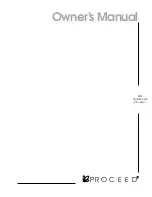
OPTIMOD-AM DIGITAL
OPERATION
3-3
crease in the loudness of soft sounds. It cannot make loud sounds seem louder.
Compression reduces dynamic range relatively slowly in a manner similar to riding
the gain: Limiting and clipping, on the other hand, reduce the short-term peak-to-
average ratio of the audio.
Limiting
increases audio density. Increasing density can make loud sounds seem
louder, but can also result in an unattractive busier, flatter, or denser sound. It is im-
portant to be aware of the many negative subjective side effects of excessive density
when setting controls that affect the density of the processed sound.
Clipping
sharp peaks does not produce any audible side effects when done moder-
ately. Excessive clipping will be perceived as audible distortion.
Loudness and density
The amount of
gain reduction
determines how much the loudness of soft passages
will be increased (and, therefore, how consistent overall loudness will be). The
automatic gain control (AGC) and the multiband limiter both provide gain reduction,
although their effects are quite different.
In a competently-designed processor, audibly objectionable distortion occurs only
when the processor is clipping peaks to prevent the audio from exceeding the peak
modulation limits of the transmission channel. The less clipping that occurs, the less
likely that the listener will hear distortion. However, to reduce clipping, you must
decrease the drive level to the clipper, which causes the average level (and thus, the
loudness) to decrease proportionally.
Receiver high frequency rolloff
introduces further complications. A typical
receiver’s severe HF rolloff reduces the headroom available at high frequencies and
makes it difficult to achieve a bright sound. This is because bright sound requires
considerable high frequency power to appear at the output of the receiver, thus
requiring a very large amount of high frequency power to be transmitted so that a
sufficient amount will survive the receiver’s rolloff.
To increase brightness and intelligibility at the receiver, the 9300’s NRSC preemphasis
boosts the treble at 6dB/octave starting at 2.1 kHz.
HF
C
URVE
settings from
0
to
10
produce more severe preemphasis than NRSC, boosting at 18dB/octave with 2 kHz up
about 3 dB. Without very artful processing, this preemphasis will radically increase the
level of the peaks and force you to decrease the average level proportionally. Orban's
high frequency limiting and distortion-cancelling clipping systems greatly ease this
trade-off, but cannot eliminate it. Therefore, you can only increase brightness by
reducing average modulation (loudness)
unless you accept the increased distortion
caused by driving the final clippers harder.
In processing, there is a
direct trade-off
between loudness, brightness, and distortion.
You can improve one only at the expense of one or both of the other two. Thanks to
Orban's psychoacoustically-optimized designs, this is less true of Orban processors than
of any others. Nevertheless, all intelligent processor designers must acknowledge and
work within the laws of physics and psychoacoustics as they apply to these trade-offs.
Содержание OPTIMOD-AM 9300
Страница 1: ...Operating Manual OPTIMOD AM 9300 Digital Audio Processor Version 2 0 Software...
Страница 7: ...Operating Manual OPTIMOD AM 9300 Digital Audio Processor Version 2 0 Software...
Страница 178: ...3 46 OPERATION ORBAN MODEL 9300...
Страница 200: ......
Страница 221: ...OPTIMOD AM DIGITAL TECHNICAL DATA 6 21...
Страница 222: ...6 22 TECHNICAL DATA ORBAN MODEL 9300 CONTROL BOARD PARTS LOCATOR...
Страница 228: ...6 28 TECHNICAL DATA ORBAN MODEL 9300...
Страница 229: ...OPTIMOD AM DIGITAL TECHNICAL DATA 6 29 I O DSP BOARD LEFT AND RIGHT ANALOG INPUTS...
Страница 230: ...6 30 TECHNICAL DATA ORBAN MODEL 9300 I O DSP BOARD ANALOG OUTPUTS...
Страница 231: ...OPTIMOD AM DIGITAL TECHNICAL DATA 6 31...
Страница 238: ...6 38 TECHNICAL DATA ORBAN MODEL 9300 FRONT VIEW REAR VIEW FRONT PANEL PARTS LOCATOR DIAGRAM...
Страница 242: ...6 42 TECHNICAL DATA ORBAN MODEL 9300 NOTES...
















































